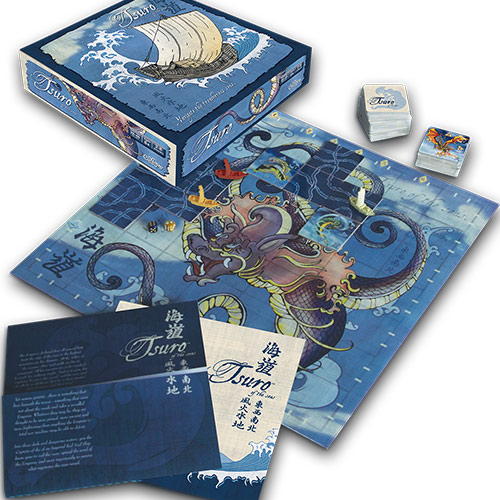The Monsters at the Edge of the World: A Review of Tsuro of the Seas

Sail the seas and survive the monsters that dwell beneath in this sequel to the hit game Tsuro.
Gameplay
The game board consists of a grid of squares. At the start of the game, each player takes a colored ship and selects a starting point from around the edges of the board. Then, depending on the number of players, a certain number of Daikaiju (monsters) are placed on the board, each one taking up an entire square. Their starting location is determined by a roll of the dice.
Each player starts the game with three tiles. Each tile shows four lines, which determine the potential movement of your ship when placed adjacent to it. On your turn, you place one of the tiles down on the empty square next to your ship and then move your along the line. While you only play one tile on your turn, if that tile connects to other tiles creating a longer line, your ship will continue to follow its line until it reaches an empty space. If a line carries your ship into a Daikaiju or off the board, then you are out of the game. If the tile you play also connects a line to your opponent’s ship then that ship also must move, meaning that it is possible to send another player to his doom.
Before you place a tile on your turn, you roll the dice. If the combined result is 6, 7, or 8, then all the Daikaiju activate. You roll one die, and on a result of 1 to 5, you move or rotate the Daikaiju as their tiles indicate for that number. On a roll of 6, you place another Daikaiju, following the placement rules from the setup.
If a Daikaiju moves onto or appears on a tile, that tile is removed and placed at the bottom of the draw stack. If a ship is on that tile, that player is out of the game. If a Daikaiju moves off the board or has another Daikaiju move on top of, it goes away. If at any time there are less than three Daikaiju on the board, players must add them until there are three.
Players continue sailing the seas and trying to avoid Daikaiju until only one player remains — this player is declared the winner.

Review
Tsuro of the Seas is lovely to look at. From its artwork and graphic design to the quality of the components, everything about the game looks and feels wonderful, and captures the feel of sailing the high seas avoiding dangerous monsters.
There’s a nice dose of strategy with the tile laying. While bad luck can wipe your ship off the face of the ocean, it’s not purely random chance. There are some locations on the board where Daikaiju are more likely to appear and some spaces where they can’t appear at all. This introduces a bit of a push-your-luck element to the game. You can sail around the edges of the board and avoid Daikaiju spawning ground, but you’re more likely to run into other players there as well. This balancing of odds verses available space adds a neat layer to the strategy of the game.
However, with some bad luck or risky plays, it is possible to be eliminated quite early from the game, and given that it can take up to forty minutes to play, this can leave a player sitting around for awhile. But if you want to play without the Daikaiju, you can do that, too — meaning that if you have this game you can also play its predecessor Tsuro.
From beautiful visuals to great gameplay, Tsuro of the Seas is well worth adding to your collection. It’s easy to learn, fun to play, great to look at, and already feels like a classic.
Pros: Looks lovely, has a nice blend of mechanics
Cons: Players can be eliminated early in the game
Disclosure: we received a complimentary review copy of this game.







